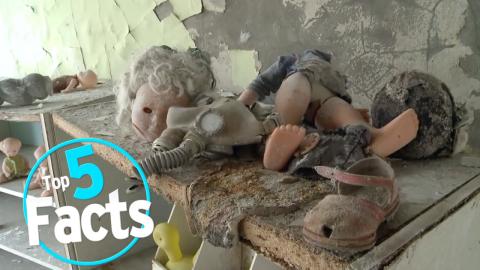Top 5 Facts about Chernobyl

In 1986 the soviet nuclear power plant in the heart of the Ukraine went into meltdown. The still radioactive core was sealed up with concrete and a 30 km exclusion zone was erected. Welcome to WatchMojo's top 5 facts. Today we'll be looking into the aftermath of the Chernobyl catastrophe.
Special thanks to our user christo for submitting the idea on our Interactive Suggestion Tool at http://www.WatchMojo.comsuggest
#5: Nobody Knows How Many People Chernobyl Has Killed
More than a hundred nuclear plant workers and first responders were killed in the weeks following the disaster, but we have no idea how many other people have died. With the exception of one rare type of thyroid cancer it’s impossible to tell which fatal cases of cancer were caused by radiation. So estimates are all over the place. The UN believes that only 4,000 people have been killed by radiation poisoning, while Greenpeace claims that 93,000 are the direct result of the meltdown. It's also estimated that 2.7 million people were affected in some way by the meltdown, this includes both the less serious medical complications and the 350,000 people that needed to be relocated.
#4: Apparently, Humans are Worse for Animals Than Chernobyl’s Radiation
Since humans have left the exclusion zone the population of animals has skyrocketed. The population of many animals is now greater than it was before the accident, and the wolf population is about 7x that of nearby areas. So basically, research indicates that chronic radiation is less of a problem to animals than the pressures of human habitation. Makes you feel proud to be a homo-sapien. However, there are a lot of negative effects in many individual animals. 4 to 6% of mice are born with birth defects. On the other hand, plant life is struggling. Biodiversity is at about 50% of similar nature reserves, but more on that shortly. So it’s not all sunshine and giant (non-mutant) catfish.
#3: The Exclusion Zone is Populated by Radioactive Grandmothers
More than a 1,000 people returned to Chernobyl after the meltdown. Today, the remaining residents are quite old and most of them are women. But many of these little old grandmothers believe that they made the right choice returning the Exclusion zone. They think this not only because it is their ancestral home, but because they survived Stalin's Genocide by starvation and watched their relocated friends and relatives end up poor and hungry in urban areas. These women are relatively healthy, and they live simple lives relying on farming soil that will be radioactive for the next 20,000 years.
#2: Chernobyl Is Home To Zombie Trees
The red Forest is one of the most radioactive places on earth. It gained that name because the trees turned a rusty shade of red just after the accident. Today the trees have become green again, but trees that die there take decades to decompose. There are still standing trees that died at the meltdown 29 years ago. This is because the radiation is killing the fungus and bacteria that would normally break down the trees, and Insects that eat plant matter choose to live in areas of the exclusion zone that are less radioactive than the forest. Recent dry summers have sparked fears of forest fires, which could send radioactive smoke to the large city of Kiev only 68 miles from the exclusion zone.
#1: A Vacation at Chernobyl is Less Harmful Than an X-Ray
Yup. You can even go to the exclusion zone on your vacation, and it only costs about 380 US for a two day tour of the site of history’s biggest nuclear disaster. Is it creepy: yes. Is it exploitative: maybe... but It does seem to be pretty safe. The radiation that you would be exposed to is less than you would get if you went to the doctor for an x-ray. For context, nuclear power plants are considered safe if their employees are exposed to less than 100 microsieverts of Gamma radiation per day, while a pelvic x-ray, for example, could expose you to 700 microsieverts. According to the tour operators, during a vacation in the exclusion zone your body would only absorb about 5-7 microsieverts.
So, how about you? Would you take a two-day Chernobyl tour? For more former soviet superpower top 10’s and radioactive top 5’s subscribe at WatchMojo.com.
